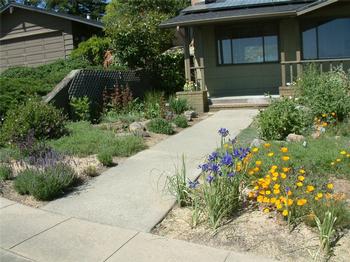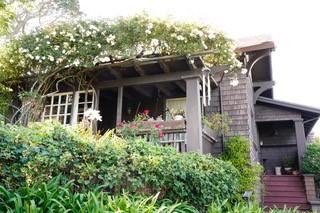Home exit fire-smart landscaping
-
Fay Mark
-
We all enjoy how landscaping enhances our homes and can benefit wildlife. But according to Marin Water, only 20 inches of rain fell at Lake Lagunitas from July 2020 until end March 2021, which is about 40 percent of average and the second-driest year in 90 years. Stafford Lake supplies about 25% of the district’s supply, with the other 75% coming from Sonoma Water. Stafford Lake was at about 42% capacity as of end March 2021.
So, what do we do as Marin County heads into another drought? Healthy, low growing, drought tolerant, pollinator friendly plants properly maintained along home exit route. Photo: GardenSoft
Healthy, low growing, drought tolerant, pollinator friendly plants properly maintained along home exit route. Photo: GardenSoftIt’s time to conserve water, but also important to keep our landscape plantings healthy, especially along the exit routes from our homes should a wildfire approach. Is there a way to conserve water, have beauty, foster wildlife habitat, and still have safe exit routes in the event of a wildfire?
The answers are yes and yes, but it takes planning and maintenance. Every homeowner must make choices that balance the need to protect themselves and their homes with their desire to maintain a vibrant landscape that supports wildlife.
Where to start? The first step is to walk each of the exits from your home to your evacuation route. Focus on the first five feet around the perimeter of your home or any other structure from which an escape may be necessary. Your goal is to determine whether the landscape plantings in the first five feet along those routes could become engulfed in flame when it is time to leave, preventing your escape.
Closest to your home, we recommend replacing planter boxes, wood mulch and plants that are dead, dying, or diseased with noncombustible alternatives. Focus on moving or pruning trees and shrubs away from the walls. Minimizing vegetation with frequent maintenance within these first five feet will reduce the potential for direct flame contact with your home and other structures on your property. For replacements, look for plants that are low growing, will not become woody over time, and retain moisture after conservative watering. Try bringing walkways closer to your home with the garden bed five feet or more from the house. In Zone 0, eliminate climbing plants, and planters made from combustible materials. Photo: Fay Mark
In Zone 0, eliminate climbing plants, and planters made from combustible materials. Photo: Fay MarkThe next step, outside the five foot border of your home, but within your evacuation route, is your lean, clean and green planting area. The goal is to eliminate connections between vegetation by increasing the spacing between trees, removing lower branches of trees and shrubs, and creating areas of drought-tolerant ground covering between lush vegetation. Plants should be properly irrigated and maintained to remove dead or dry material.
With this year’s drought, prioritize mature shrubs and trees for watering. Choose those that are healthy and harder to replace if they perish. Using an efficient irrigation system connected to a programable controller is an excellent way to control water usage. In lieu of an irrigation system, one or two slow, deep waterings with a garden hose several weeks apart in spring and summer will reach the root zone, keeping your valued plants alive through summer. Soaker hoses work well, too. Water mature trees several feet out from the trunk and make sure water is moving through the soil deep into the root zone.
With good planning and on-going maintenance, you can continue to have a gorgeous, thriving fire-smart landscape. Grab a glass of your favorite beverage, a small bucket, and walk the perimeter of your home, observing the health of your plants and cleaning up along the way. When you are done with your beverage, you are done with your maintenance for that day. You will have made progress towards defending your home while preserving the landscaping that brings enjoyment to you and the wildlife. For more information on fire-smart landscaping, please visit http://marinmg.ucanr.edu/BASICS/FIRESMARTLANDSCAPING/.


